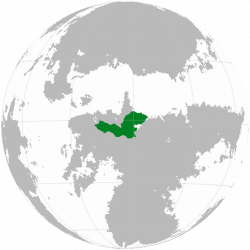Azerin
 | This article or section is out of date. A country/countries relevant to this article have been removed from Sahar and have been retconned. Not everything here may still be considered canonical. This article was last edited by Arryog (talk | contribs) 14 months ago. (Update) |
| Iovist Republic of Azerin Jovika Velfio Azaran |
||||||
|---|---|---|---|---|---|---|
|
||||||
| Motto: United by pact and religion gól edʔi arazanov es šolas jež žurid |
||||||
| Capital and city | Stalo | |||||
| Official languages | Azri | |||||
| Demonym | Azeri | |||||
| Government | Federal theocratic presidential republic | |||||
| - | Adriah | Livj Ile | ||||
| - | President | Ǧavri Palkešk | ||||
| - | Vice President | Sjmión Čirla | ||||
| Legislature | Parliament | |||||
| - | Upper house | Federation of Tribes | ||||
| - | Lower house | Consultive Assembly | ||||
| Area | ||||||
| - | 1,782,942 km2 688,398 sq mi |
|||||
| Population | ||||||
| - | 2014 census | 91,192,200 | ||||
| - | Density | 51.1/km2 132.3/sq mi |
||||
| GDP (PPP) | 2014 estimate | |||||
| - | Total | $1.284 trillion | ||||
| - | Per capita | $16,463 | ||||
| GDP (nominal) | 2014 estimate | |||||
| - | Total | $402.700 billion | ||||
| - | Per capita | $5,165 | ||||
| Gini (2014) | 38 medium |
|||||
| HDI (2014) | 0.749 high |
|||||
| Currency | Azri Yeso, Ekuo (AYS) | |||||
| Time zone | SCT (SCT+2) | |||||
| Date format | dd-mm-yyyy | |||||
| Drives on the | left | |||||
| Calling code | +52 | |||||
| Internet TLD | .az | |||||
Azerin (Azri: Āzāran [ɒːzɒːˈɾæːn]), officially the Iovist Republic of Azerin, is a country located in Ekuosia. It shares land borders with Rosland and Veridia to the north, Utol and Sorteic to the west, the Algazi Union to the south, and Barradiwa to the east. While a large portion of the country is inland, the country also borders the Parshita Sea to the northeast, and Lake Khuda, the largest lake in Baredina, to the east. Comprising an area of almost 1.8 million km2, and with a population of over 91 million, it is the EkU’s third-largest country and the third-most populated country in western Ekuosia, after Cerman and Letzia. The country’s southern border is largely defined by the Ekuos River.
The region surrounding the Ekuos-Khuda valley, known historically as Halaria, is the site of the earliest known examples of writing, agriculture and urban settlement on Sahar, and is thus often called a cradle of civilisation. Beginning with the Ancient Halarian period from around 3500 BCE, the area around Lake Khuda, Stalo, Amalo and the semi-legendary city of Halar catalysed much of the early technological progress in the Ekuosian subcontinent. During the late 3rd millennium BCE an influx of Letsic-speaking peoples from the west led to a widespread period of cultural symbiosis. The prophet Iovi is traditionally believed to have founded the Iovist religion around 1300 BCE, which was rapidly adopted in eastern Azerin and spread across Ekuosia. The Letsatian Empire conquered much of what is today western and central Azerin around 200 BCE, but Halaria and Amalo remained sovereign. Following the fall of Letsatia, Azerin was largely governed by a collection of petty kingdoms, city-states, and tribal fiefdoms, later falling under the control of the Terminian Empire from the late 13th to mid 15th centuries. Around 1500 CE much of modern Azerin was conquered by the Ignazian Empire.
For most of the period between the 17th to 20th centuries, Azerin was made up of a large number of successive coexisting states. Towards the end of the 1800s, the idea of a single Azri nation-state, united by language, religion, and culture, was developed within academic circles in Halaria and Amalo. In 1904, an agreement was reached between the 17 Azri states establishing a federal theocratic government in the Halarian capital of Stalo and giving rise to the modern nation of Azerin. The fledgeling nation inherited Halaria's close alliance with its eastern neighbour Barradiwa, and the invasion of Azerin by Jol Giradz’s Veridia in 1946 led to the Great Ekuosian War.
In the 21st century, Azerin is a founding member of the Ekuosian Union and the International Congress. It is considered a developing country, with the lowest GDP per capita in the EkU. The country continues to face challenging problems, including poverty, illiteracy corruption. Despite this, the east of the country has seen significant development in modern times, and Azerin’s position as the centre of Orthodox Iovism has given it considerable regional influence. Azerin has a semi-industrialised economy, with a large agriculture sector and a growing services sector. Stalo is the country's capital and largest city, as well as its leading cultural and economic centre.
Etymology
History
Geography
Geology
Climate
Biodiversity
Politics
Government
Administrative divisions
Foreign relations
Military
Economy
Transport
Energy
Science and technology
Tourism
Demographics
Ethnic groups
Urbanisation
Language
Education
Healthcare
Religion
Culture
Heritage
Architecture
Literature
Art
Music
Theatre
Film
Cuisine
Sport
Symbols
See also
 |
Rosland • Veridia |
Parshita Sea | 
| |
| n/a | Lake Khuda | |||
| ||||
| n/a | Khuda River |


